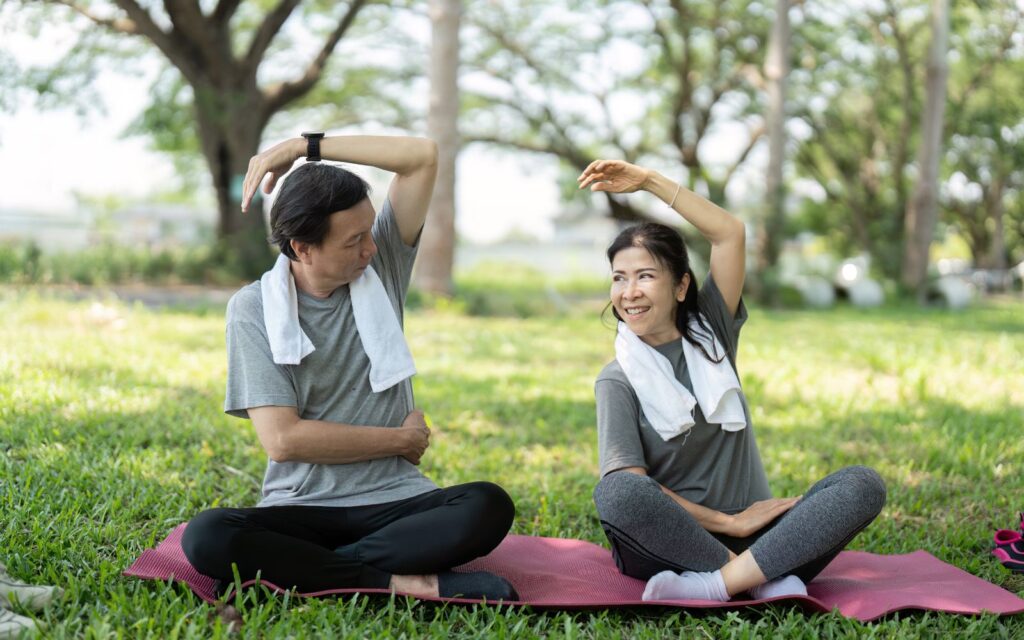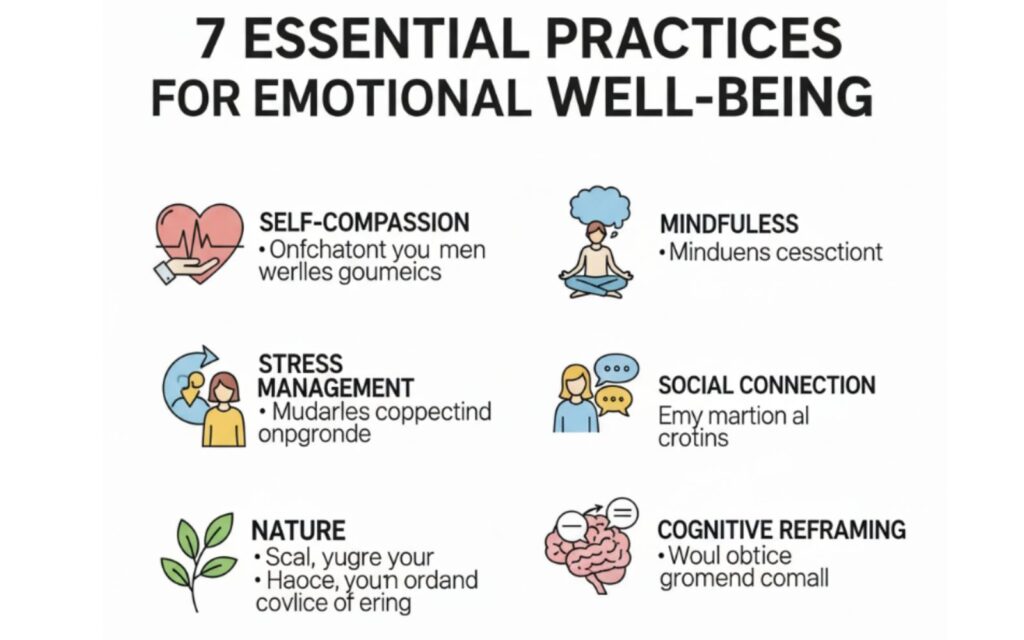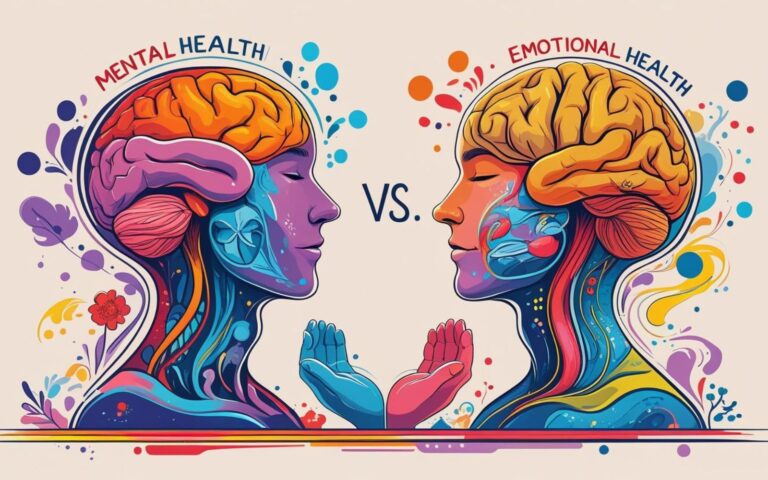7 Evidence-Based Practices for Emotional Well-being That Transform Your Daily Life

Did you know that 76% of adults report experiencing physical symptoms caused by stress, yet only 34% actively engage in practices for emotional well-being? This staggering gap reveals a critical challenge many face: knowing that mental health matters but struggling to implement sustainable habits that actually work.
Whether you’re juggling work deadlines, family responsibilities, or simply trying to find balance in an increasingly demanding world, developing consistent emotional wellness practices isn’t just beneficial-it’s essential for thriving in both your personal and professional life.
In this comprehensive guide, you’ll discover seven research-backed practices for emotional well-being that can be seamlessly integrated into even the busiest schedules.
Drawing from my decade of experience in wellness coaching and backed by psychological research, these strategies offer practical solutions for building resilience, managing stress, and cultivating lasting emotional balance.
Understanding the Foundation of Emotional Well-being

Emotional well-being encompasses more than just feeling happy or avoiding negative emotions. It’s about developing the capacity to navigate life’s challenges with resilience while maintaining a sense of purpose and connection.
Research from the American Psychological Association shows that individuals who actively engage in emotional wellness practices report 23% higher life satisfaction and 40% better stress management.
The key lies in consistency rather than perfection. Small, sustainable changes create lasting transformation.
7 Essential Practices for Emotional Well-being

1. Mindful Morning Rituals
Starting your day with intention sets the tone for emotional stability. A mindful morning routine doesn’t require hours-even 10 minutes can make a significant difference.
How to implement:
- Wake up 10 minutes earlier than usual
- Begin with three deep breaths before checking your phone
- Practice gratitude by listing three things you appreciate
- Set a positive intention for the day
Common mistake to avoid: Don’t try to overhaul your entire morning at once. Start with just one element and gradually build.
2. Emotional Check-ins Throughout the Day
Regular emotional awareness prevents small stressors from becoming overwhelming. This practice helps you identify patterns and triggers before they escalate.
Implementation steps:
- Set three daily reminders on your phone
- Ask yourself: “How am I feeling right now?”
- Rate your stress level from 1-10
- Take appropriate action based on your assessment
Studies from Harvard Medical School indicate that people who practice regular emotional check-ins experience 30% less burnout.
3. Nature Connection for Mental Reset
Spending time in natural environments-even urban green spaces-significantly impacts emotional well-being. This eco-friendly approach to mental health costs nothing and provides immediate benefits.
Practical applications:
- Take a 15-minute walk in a park during lunch
- Keep plants in your workspace
- Practice “forest bathing” by mindfully observing natural surroundings
- Garden or tend to houseplants as active meditation
The Japanese practice of shinrin-yoku (forest bathing) has been shown to reduce cortisol levels by up to 50%.
4. Boundary Setting for Emotional Protection
Healthy boundaries are essential practices for emotional well-being that protect your energy and prevent emotional exhaustion. This skill is particularly crucial in our hyper-connected world.
Boundary-setting strategies:
- Learn to say “no” without over-explaining
- Designate specific times for checking emails and social media
- Create physical spaces that are technology-free
- Communicate your limits clearly and kindly
5. Movement as Emotional Regulation
Physical activity directly impacts emotional state through the release of endorphins and the reduction of stress hormones. You don’t need gym memberships or expensive equipment.
Accessible movement options:
- Dancing to favorite music for 10 minutes
- Stretching during TV commercial breaks
- Walking meetings when possible
- Yoga or tai chi in your living room
Research shows that just 150 minutes of moderate exercise weekly can reduce anxiety symptoms by 20%.
6. Social Connection and Support Systems
Human connection is fundamental to emotional well-being. Quality relationships provide resilience, perspective, and joy during both challenging and celebratory times.
Building meaningful connections:
- Schedule regular check-ins with close friends or family
- Join community groups aligned with your interests
- Practice active listening in conversations
- Express appreciation to people who matter to you
7. Evening Reflection and Preparation
Ending your day with reflection helps process emotions and prepares your mind for restorative sleep. This practice creates closure and sets positive expectations for tomorrow.
Evening routine elements:
- Journal about the day’s experiences and emotions
- Identify one lesson learned or success achieved
- Practice forgiveness for any mistakes made
- Set intentions for the following day
Practical Takeaways
- Start small: Choose one practice and commit to it for two weeks before adding another
- Create environmental cues: Place reminders in visible locations to support new habits
- Track progress: Use a simple journal or app to monitor how practices affect your mood
- Be flexible: Adapt these practices to fit your lifestyle and circumstances
- Seek support: Share your emotional well-being goals with trusted friends or professionals
Building Your Sustainable Emotional Wellness Routine

The most effective practices for emotional well-being are those that seamlessly integrate into your existing lifestyle. Start by identifying which of these seven practices resonates most with your current needs and circumstances. Remember that building emotional resilience is a journey, not a destination-be patient with yourself as you develop these life-changing habits.
Research consistently shows that people who maintain regular emotional wellness practices experience greater life satisfaction, improved relationships, and enhanced ability to handle stress. By implementing even a few of these strategies, you’re investing in your long-term mental health and overall quality of life.
Which practice will you start with today? Share your commitment in the comments below, and remember to check out our related articles on stress management and mindfulness techniques. Don’t forget to share this guide with someone who could benefit from these evidence-based strategies for emotional well-being.
FAQs About Practices for Emotional Well-being
How long does it take to see results from practices for emotional well-being?
Most people notice initial improvements in mood and stress levels within 2-3 weeks of consistent practice. However, lasting changes in emotional resilience typically develop over 8-12 weeks of regular implementation. The key is consistency rather than intensity.
Can practices for emotional well-being help with clinical anxiety or depression?
While these practices are beneficial for everyone, they work best as complementary strategies alongside professional treatment for clinical conditions. If you’re experiencing persistent anxiety or depression, consult with a mental health professional who can provide personalized guidance.
What’s the minimum time commitment needed for effective practices for emotional well-being?
You can start with just 10-15 minutes daily. Even brief, consistent practices yield significant benefits. As habits strengthen, you can gradually increase time investment, but sustainability matters more than duration.
How do I maintain practices for emotional well-being during busy or stressful periods?
During challenging times, simplify your practices rather than abandoning them entirely. Focus on just one core activity like deep breathing or brief gratitude reflection. These micro-practices often provide the most value when you need them most.
Are there specific practices for emotional well-being that work better for different personality types?
Yes, introverts often prefer solitary practices like journaling or nature walks, while extroverts may benefit more from social connection and group activities. Experiment with different approaches to find what feels most natural and sustainable for your personality and lifestyle.





